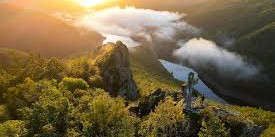The Treasures of the Aubrac Regional Nature Park
Located in the southernmost part of the Massif Central, Aubrac is a medium mountain range surrounded by the rivers Lot and Truyère. This area offers remarkable diversity, from variations in altitude to climatic influences, and from various types of rocks to varied landscapes. The Aubrac Regional Nature Park is home to a wealth of natural, architectural, and cultural heritage, recognized beyond its borders and contributing to the economic and social development of the region.
The varied landscapes of the Aubrac Park
The Parc de l'Aubrac is renowned for its vast and open plateau landscapes, where the breeding of the famous Aubrac cattle breed is omnipresent. These lands are ideal for hiking and outdoor activities, offering a terrain conducive to exploration. In addition to its vast grasslands, the park is home to forests, winding streams and bogs, creating a great diversity of ecosystems. This mix of landscapes makes the Aubrac a perfect place for nature lovers.
Fauna and Flora of the Aubrac Park

The Parc de l'Aubrac is a true haven of biodiversity. Its fauna is rich and varied, with animals such as deer, roe deer and chamois, which live in these preserved landscapes. Many species of birds, such as the grouse, also find refuge there. As far as flora is concerned, the Aubrac is a paradise for alpine plants and rare flowers. The grasslands of the park are dotted with magnificent plant species, offering botanical enthusiasts a colorful and unique spectacle. This mixture of fauna and flora makes the Aubrac a favorite place for nature lovers.
A recent regional natural park
The Regional Natural Park of Aubrac was created in order to protect and enhance an exceptional territory, recognized for its biodiversity, landscapes and cultural heritage. Although the idea of preserving and managing this territory emerged long before, the park officially became a Regional Natural Park (NRP) in 2018.
The Aubrac is a natural region located at the crossroads of Aveyron, Cantal and Lozère. This territory is distinguished by its wild plateaus, forests, streams and diverse fauna and flora.
The development of this park was motivated by several major issues:
Nature conservation: The Aubrac is home to a great ecological wealth, with rare species and an environment still largely preserved. Park status protects these areas while promoting sustainable development.
Cultural heritage: The region is also marked by strong traditions and history, including the breeding of the Aubrac cow and the production of famous cheeses such as the Aubrac cheese. The park aims to enhance this heritage while supporting local agricultural and craft activities.
Tourist attraction: The park has become a privileged site for nature lovers, hikers and heritage enthusiasts. The creation of the NRP has made it possible to structure the tourist offer and integrate local actors in a sustainable development project.
Outdoor activities of the Parc de l'Aubrac

The Parc de l'Aubrac is an ideal destination for outdoor enthusiasts. It offers a multitude of options, such as hiking, mountain biking, and wildlife watching, allowing you to experience the beauty of the park from different angles. In winter, cross-country skiing is a great option for snow sports enthusiasts. The park also allows you to immerse yourself in local crafts, discovering traditional know-how. In addition, you can explore the region through themed tours, such as the Santiago de Compostela trails, which cross the park and add a historical dimension to the adventure
The Animations of the Parc de l'Aubrac
The Parc de l'Aubrac also offers various animations to enrich the experience of visitors. In the summer, events such as music festivals, local producers' markets and exhibitions on the history and culture of the region are organized to discover the wealth of the aubracian heritage.
Workshops to discover nature and local traditions are also offered, such as demonstrations of cheese making, guided walks on the trails, or wildlife viewing sessions. In winter, activities around cross-country skiing and snowshoeing are organized, as well as village festivals to celebrate the traditions of the region. These activities allow visitors to immerse themselves in the unique atmosphere of the Aubrac, while discovering the local customs and natural beauties of the park.
Jean-Pierre Bouissou, the Robin d'Aubrac
The Aubrac, this wild and isolated region of northern Aveyron, is a territory both majestic and mysterious. Known for its vast plateaus, dense forests and desert landscapes, it has long been the birthplace of many legends and stories about bandits.
Jean-Pierre Bouissou, nicknamed the Thief of Alpuech, was an emblematic robber of the north of Rouergue in the 18th century. Born in 1763, he used to roam the heights of the region, mainly around Alpuech, Laguiole and Cassuéjouls. Just like Mandrin, he took from the rich to give to the poor, rejoicing in robbing the merchants and bourgeois returning from the fair. Lonely and feared, he was armed and often helped by the inhabitants and even accomplices in the forces of order.
Condemned to death several times, Bouissou ends up being killed by gendarmes ambushing at the Terrisse, betrayed for a few Louis. His legend will live, and he will be compared to a "Robin Hood" of the revolutionary era. His exploits in the mountains of northern Aveyron still feed the popular imagination and inspire today creations such as the collection of knives "Robin d'Aubrac".
How to get to the Aubrac regional park?
To get to the Parc Régional de l'Aubrac from the Presqu'île de Laussac, here is the itinerary:
From the Presqu'île de Laussac, take the D920 road south towards Saint-Amans-des-Cots.
Then continue on the D9 which will take you to Aumont-Aubrac. This route crosses picturesque landscapes of the Cantal, before reaching the central area of the park.
Once in Aumont-Aubrac, you are at the heart of the park. There are several access points to discover the region, such as the Plateau de l'Aubrac, Nasbinals or Saint-Chély-d'Aubrac.
